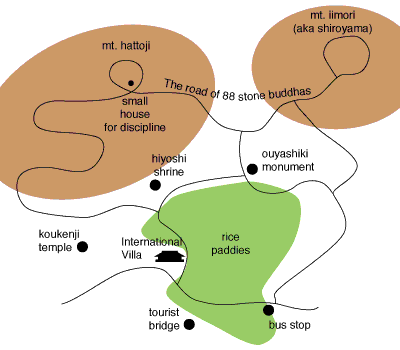Hattoji

Hattoji |
 |
| The highlight of my trip to Japan was a 4-day, 3-night stay in Hattoji. I was looking for somewhere that really expressed traditional, rural Japan, and I truly found it in Hattoji. |
Hattoji (the name translates literally as 8-tower-temples) was a center for sangaku mountain buddhism starting around the year 728, when the two still-extent temples were founded. For awhile, Hattoji was actively fought over by different clans, but it's importance eventually declined with the gradual withdrawl of Buddhist monks from politics. Now, Hattoji is a very quiet and quite isolated small mountain village. It's been designated a furusato village, which I believe means something like 'old way of life'), where they actively preserve old buildings and old forms of agriculture.
|
Places I went in Hattoji: Other places that were near Hattoji: |
 |
I had to put the Bus stop on the map, because it occupied so much of my attention and because it help express how small and isolated Hattoji is. The only public transportation in or out of Hattoji is the "Bizen Bus", a local 16-seater than runs between Hattoji, Yoshinaga (the nearest train station), and Bizen twice a day. Therefore, all getting in or out of town centered on the bus for me - especially important because there were no restaurants or grocery stores in Hattoji, so the bus was the key to continued eating (I shopped at the grocery store in Yoshinaga and cooked in the Villa's kitchen).
To my knowledge, no one in Hattoji spoke English. I spoke only Japanese for the four days I was there, which is probably a big part of why I liked it. However, the fact that my Japanese is so bad made even the simplest transactions ("Is this the last bus?") an ongoing linguistic challenge. I was very lucky in that the Bizen Bus driver was a very patient and friendly fellow, and he greatly helped me figure out what I had to do in my four days there. Among other things, he was the person who pushed me to go to Shizutani Gakkou -- a worthwhile idea indeed.
Most Japanese who come to Hattoji do so by car, and from the looks of the town, in summer there are a reasonable number of tourists. In the season I was there, though (September), I saw only a few Japanese day tourists taking pictures of the buildings, and no other westerners at all for the four day period.
| previous Wadayama | map Japan | next Hattoji Villa |
| © 1998 Leo Hourvitz |